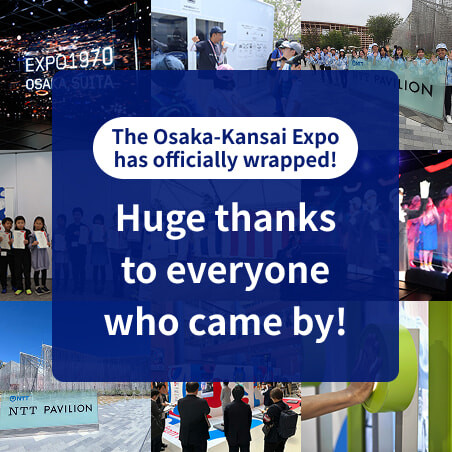Microsoft ends support for Internet Explorer on June 16, 2022.
We recommend using one of the browsers listed below.
- Microsoft Edge(Latest version)
- Mozilla Firefox(Latest version)
- Google Chrome(Latest version)
- Apple Safari(Latest version)
Please contact your browser provider for download and installation instructions.
Biodiversity
Our Policy and Approach
The NTT Group's businesses have an impact on ecosystems. For example, the telecommunication equipment essential to our business operations, particularly telephone poles and communications cables, is installed in the natural environment. At the same time, we are sometimes affected by the ecosystem, for example cables are bit and damaged by squirrels or crows. Ecosystems full of biodiversity provide the bounty, such as water and food, which is critical to supporting all forms of life on earth, and thus require a proper approach for conservation.
Through NTT Group business and employee activities, we will promote initiatives related to deforestation prevention and biodiversity (in consideration of natural capital) along with our suppliers and partners to ensure that nature is left untouched for future generations.
The NTT Group views the preservation of biodiversity as a key issue, and based on internationally recognized mitigation tiers (avoid, minimize, recover, offset), we are engaged in initiatives to minimize the impact of our business activities on biodiversity. For example, when constructing new renewable energy facilities, we conduct an environmental impact assessment (environmental assessment) as dictated by the Environmental Impact Assessment Act to conduct and assess the impact on ecosystems (flora and fauna), identifying and avoiding risks (in the case of wind power, preventing collisions of birds of prey as well as conducting research and maintenance management that takes into consideration the ecology of birds, mammals, and more) as we implement measures that mitigate effects on nature.
The NTT Group also views preservation of biodiversity as a key issue. The NTT Group Supply Chain Sustainability Promotion Guidelines state that business activities undertaken by us or our supply chain must avoid business activities in areas close to globally and domestically important biodiversity zones (consideration to biodiversity).
Initiative Example (1): Natural Capital Monitoring
In March 2025, development of remote sensing technology for estimating vegetation and organisms across a wide area began at BIOME, DOCOMO BUSINESS, DOCOMO SOLUTIONS, NTT DATA, and DOCOMO. Combining NTT Group assets such as satellite image analysis technology and BiomeDB, Biome's real-time organism database, which is one of the largest in Japan and contains over 10 million items, we helped establish a method of continuously collecting and analyzing data over a wide area related to vegetation and organisms for supporting biodiversity monitoring. This promotes efforts to minimize the impact on biodiversity and contributes to achieving nature positivity as a society.

Initiative Example (2): Creation of a Medium-Term Biodiversity Roadmap
DOCOMO has created a roadmap for its efforts toward contributing to the "2030 Nature Positive" and "2050 World In Coexistence with Nature" initiatives. Through consideration of biodiversity in areas surrounding telecommunications equipment (measures considering biodiversity around base stations, enhanced stakeholder engagement when installing base stations, stakeholder participatory biodiversity conservation at areas around other telecommunications equipment), addressing mineral resources (encouragement of suppliers, promoting resource recycling), using company assets (ICT use, participating in planning of local bases), and more, we enhance our biodiversity conservation efforts while also preventing forest destruction.
Organization for Implementation
Activities (key issues) based on the three themes and nine challenges of a sustainable society as viewed by NTT in the "NTT Group Global Sustainability Charter," including biodiversity, are selected and reviewed after discussion at the Sustainability Committee and approval by the Board of Directors.
Targets and Performance
Sustainability Indicators
*You can scroll horizontally
| Item | Fiscal 2024 target | Fiscal 2024 results | Fiscal 2025 target |
|---|---|---|---|
| (5) Number and percentage of business facilities located in protected natural areas  |
No target is set for monitoring purposes. | Number of equipment units:913Sites Percentage of Total:4.6% |
No target is set for monitoring purposes. |
| (6) Number and percentage of business facilities located in water risk regions  |
No target is set for monitoring purposes. | Number of equipment units:23Sites Percentage of Total :0.4% |
No target is set for monitoring purposes. |
Boundary:NTT Domestic and overseas Group companies
This fiscal year, an overview of a business facilities screening is being published, while for risks, disclosures are being expanded by adding TCFD. Opportunities are being investigated by disclosing examples of solutions and more using ICT.
For indicators and targets that have not been disclosed, core metrics indicated in the TNFD Recommendations, European Sustainability Reporting Standards (ESRS), and more will be taken into consideration as future investigations are carried out.
Major Efforts
Analysis of Nature-Related Issues
The NTT Group operates across diverse segments, including telecommunications, data centers and renewable energy.We analyzed the Group's dependencies and impacts on nature through the following process.

Step1:Identifying dependencies and impacts by facility type

Following the TNFD-recommended LEAP approach, the NTT Group focused on facilities that support service groups with the greatest revenue impact--base stations, telecommunications infrastructure, and data centers--to identify nature-related dependencies and impacts, then assessed the likelihood of risk materialization.
Based on general evaluation results from ENCORE*, we visualized how each business depends on and affects ecosystem services and natural capital using a heatmap.

*ENCORE: Using the results from ENCORE, an online dependency and impact analysis tool developed by the Natural Capital Finance Alliance (NCFA) and the UN Environment Programme World Conservation Monitoring Centre (UNEP-WCMC), and referenced by the TNFD
We identified the following key areas of dependency and impact.
| Dependency |
|
|---|---|
| Impact |
|
*Measures to address these impacts are described in Step 2.
Step2:Addressing impacts and confirming risks

Considering materiality, we assessed biodiversity and water use impacts not only for the base stations and data centers identified by ENCORE, but also for telecommunication facilities with a building area over 1,000 m² and for renewable energy facilities such as solar and wind power that may have larger impacts on nature.
1) Biodiversity Conservation
Using Key Biodiversity Areas (KBAs)*2, we screened and conducted in-depth surveys on approximately 20,000 sites of base stations*1, telecommunication facilities, and data centers considered to have significant impacts on nature.
As in the previous year, renewable energy facilities (solar and wind power) are expected to have significant dependencies and impacts, so we interviewed construction companies to confirm how they address these risks.
*1Base stations with antennas installed more than 30 meters above ground.
*2Key Biodiversity Areas (KBAs), internationally recognized priority areas for biodiversity.
2) Water Use
For data centers, we used the "Aqueduct"*3 and "ThinkHazard!"*4 analytical tools to assess water stress, then conducted in-depth surveys of sites rated "Extremely High" or "High" to identify potential impacts.
*3Aqueduct is a water risk assessment tool developed by the World Resources Institute.
*4ThinkHazard! is a tool developed by the Global Facility for Disaster Reduction and Recovery (GFDRR) in collaboration with the World Bank Group and other organizations.
Step 3: Survey Results


1)Biodiversity Conservation
For the base stations and telecommunications facilities reviewed in-depth, we contacted local municipalities to determine whether any concerns had arisen regarding impacts on surrounding ecosystems.No concerns were identified for the facilities, and we concluded that potential business risks are limited.
For renewable energy facilities such as solar and wind power, we conduct environmental impact assessments in accordance with Japan's Environmental Impact Assessment Act and other relevant legislation and evaluate potential impacts on local ecosystems (flora and fauna).The environmental impact assessment process involves four stages--preliminary considerations, methodology, draft report, and final assessment report--with results disclosed on each company's website for a legally mandated period.For wind power projects, we study, predict, and evaluate the risk of bird strikes, particularly those involving birds of prey. For projects already in operation, we conduct long-term monitoring under expert guidance, ensuring that development and maintenance take into account the conservation of birds, mammals, and other wildlife.
2) Water Use
Our analysis identified three water-cooled data centers located in regions with extremely high water stress.
A review of these data centers showed that for two sites in South Asia, groundwater is currently used, but local utilities are expanding supply systems that use surface water. A shift to municipal water is expected, which should reduce risks associated with groundwater dependence.
We are also examining ways to reduce water intake at facilities in water-stressed areas to minimize impacts on local communities and the environment.
At the other site, the local utility uses recycled wastewater, and we confirmed that water resources in the operating area are being appropriately managed.
Raw materials procurement
Overview of nature-related risks at the mining stage of metal raw materials
The NTT Group conducts biodiversity and water risk surveys across the entire supply chain (upstream and downstream) related to metal resource mining areas as part of risk management.
For the mining stage of metal raw materials, we focused on copper, iron, aluminum, and rare metals as four major types of metals, and conducted an assessment of the primary mines in the major producing countries with large exports to Japan in terms of biodiversity and water risk. As a result of this assessment, we found that biodiversity risk is high at a very large number of mines, and water risk is also high in about half of the mines, which could have significant impacts on nature.
In order to promote efforts in the supply chain for the realization of a sustainable society, the NTT Group requests that suppliers comply with the NTT Group Supply Chain Sustainability Promotion Guidelines and NTT Group Green Procurement Standards, and conducts company and product evaluations as well as periodic surveys and studies of the status of environmental conservation efforts. Within these frameworks, we will strengthen our dialogue with suppliers regarding the conservation of nature and biodiversity, and discuss strengthening our efforts to conserve biodiversity and regional water resources in upstream processes, including the mining of metal resources.
Status of biodiversity risk and water risk associated with primary mining areas for metal resources
*You can scroll horizontally
| Metal type | Primary equipment used for | Ratio of locations in regions with high biodiversity risk | Ratio of locations in regions with high water stress |
|---|---|---|---|
| Copper | Power lines, Telecommunications equipment |
91.7% | 41.7% |
| Iron | Steel towers, antennas, building materials |
93.8% | 12.5% |
| Aluminum | Steel towers, antennas | 84.6% | 69.2% |
| Rare metals(tantalum) | Electronic parts | 85.7% | 57.1% |
| Total | 89.6% | 41.7% | |
Remarks
Biodiversity risk: Using the biodiversity risk assessment tool (IBAT), locations were judged as high risk if they were within 70 km of a KBA or conservation area.
Water risk: Using WRI Aqueduct 2019, production bases were judged as high risk if there was "High" or "Very High" Baseline Water Stress.
Also, ratios are based on the number of survey sites per metal type (major mines in primary producing countries) as the denominator. For rare metals, tantalum was selected in light of the availability of location data in primary statistics, keeping in mind the raw materials of electronic parts in the telecommunications business.
Regarding risks and opportunities for major sustainability-related items, matters are brought to the Sustainability Committee, then reported to the Board of Directors. Additionally, as part of the NTT Group's risk management process, the Business Risk Management Promotion Committee--headed by the senior executive vice president-- along with the Group Business Risk Management Promotion Committee are central to establishing and operating a PDCA cycle for risk management, with the aim of anticipating and preventing the occurrence of the potential risks close at hand and minimizing losses in the event that risks do materialize. The processes concerning the identification, evaluation, and management of sustainability-related risks are integrated into the NTT Group's overall risk management framework.
Initiatives to prevent forest destruction
From the viewpoint of efficient use of resources, rather than mining new rare metals, we recycle used products to efficiently collect materials. Centered on DOCOMO, the NTT Group promotes mobile phone recycling, which entails collecting and recycling used mobile phones at DOCOMO shops across the country and through other events. This initiative promotes reuse of rare metals and reduces the impact on the environment in terms of deforestation and destruction of the ecosystem associated with new mining efforts.
In fiscal 2023, the Docomo Sennan Horigo no Mori (Osaka) was certified as a "Nature Coexistence Site" by the Ministry of the Environment of Japan. We are working to protect the nature-filled environment of the mountain villages of southern Osaka and the woodland around them, as well as the various living creatures there such as the great purple emperor and the Japanese common toad along with their ecosystem.
We continued such initiatives in fiscal 2025, with Docomo Toki no Mori (Gifu) and Docomo Shikoku Tosa Ino Genki no Mori (Kochi) newly receiving certification and more. Our goal is to have five certified nature coexistence sites around Japan by fiscal 2027.
Contributing to Biodiversity Preservation and Transitioning to a Circular Economy
The NTT Group believes the increasing focus on biodiversity and a recycling-oriented society opens up new business opportunities. We will continue to contribute to the achievement of a sustainable society through our business activities. We will continue to verify and disclose risks and opportunities related to biodiversity and resource circulation for the NTT Group.
Forest Conservation
By actively promoting technological innovation aimed at conserving forests, we increase carbon dioxide absorption, conserve and protect ecosystems and water resources, and contribute to the achievement of a sustainable society.
For example, we have conducted an operational field demonstration of a self-driving underbrush clearing machine (called "the demonstration" below) developed to reduce the cost of clearing away underbrush through forestry labor-saving and automation.
During the demonstration, we used the above machine to clear away underbrush at an actual forestry site, thereby verifying the machine's operational performance.
The machine was operated by setting a self-driving route and using a tablet with a special application for remotely monitoring the vehicle installed on it.

Comprehensive support for the creation, validation, and trading of forest-derived J-Credits
Since August 2024, SUMITOMO FORESTRY CO., LTD. and NTT DOCOMO BUSINESS have offered the "Forest Value Creation Platform" ("Morikachi")."Morikachi" is a comprehensive platform that supports the creation, validation, and trading of forest-derived J-Credits*1.For the first time in Japan*2, "Morikachi" provides GIS*3 capabilities to credit creators, validators, and buyers, streamlining issuance processes and enhancing credit reliability to promote greater issuance and distribution.
*1Forest-derived J-Credits are government-certified credits representing CO2 absorption from proper forest management such as thinning.
*2Based on joint company research
*3GIS (Geographic Information System) is a technology for managing and visualizing spatial data, enabling advanced analysis and rapid decision-making.

Environment
NTT STORY
WEB media that thinks about the future with NTT










